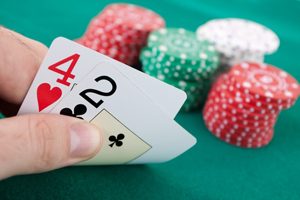
Just as implied odds can turn into reverse implied odds, bluff equity can also turn into reverse bluff equity. Imagine we are playing a hand with a nut blocker, planning a strong bet if a flush draw appears in the game, because we believe the opponent will never play a draw with what they currently have. If they decide to play a flush draw with what they have, contrary to our expectations, we ourselves risk losing more money than we had planned if the flush card indeed comes out. Using bluff equity against a player who slow-plays or structures their range differently than we think can backfire on us. Besides bluff and reverse bluff equity, there is another important aspect that most people misunderstand.
A question to ponder: what kind of hand do you want to represent to people when you bluff? Most people intuitively answer: a strong one. But this is undoubtedly a mistake.
If we think carefully, your opponent cares little whether your hand is strong or not; what matters to them is whether their hand can beat yours. So, if they have a weak hand, you don't need to represent a strong one; you just need to show that you have a slightly stronger hand than theirs.
This is a common mistake among poker players thinking about bluffing. They focus on bluffs in spots where they can represent having a flush or a straight, sets, or overpairs and other similar hands. But in reality, all these hands have a very low frequency. You don't get them as often as you'd like. So why try so hard to show that you have them?
Instead, it's better to show that you have a medium pocket pair or a top pair with a low kicker. You should more often use bluff sequences like check/check/bet, check/bet/bet, or bet/check/bet; such sequences naturally indicate weaker types of hands. You get such hands often enough, so you can bluff more frequently. This way, you won't win big pots, but the pots you do win will contribute to your results in the long run. Winning 10bb per 100 hands clearly increases your win rate.
The next bluff principle can be considered a higher-level principle because it heavily depends on psychology. Let's conclude that the opponent is quite smart and actively thinks about your ranges. You are in a situation where all your hands will have at least some showdown value. Eventually, your opponent will conclude that you will choose the least risky path (this is usually a good assumption). So, when they know that you will likely check more often and only occasionally win by chance without risking anything, the opponent will assume that this is not a bluff. Thus, they will reduce your bluff frequency to a minimum. And this is exactly when you should bluff.
In general, this principle would sound like this: in situations where the opponent thinks you have no reason to bluff, you should bluff. Of course, this principle only applies if the opponent thinks about such things or the spot is far enough from the center that they consciously consider the possibility of a bluff. If they don't think about your psychology or are simply distracted, then this principle can be thrown overboard.
As you can see, bluffing is much more than just representing a strong hand; there are many subtler aspects to it.





